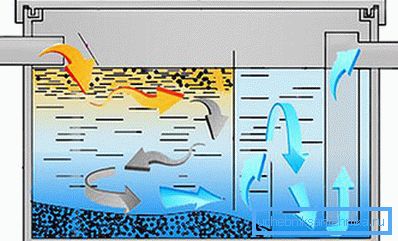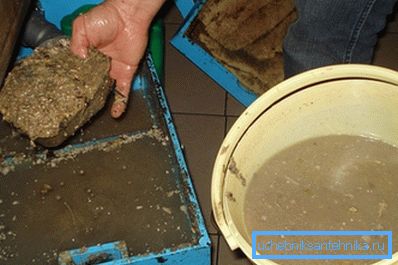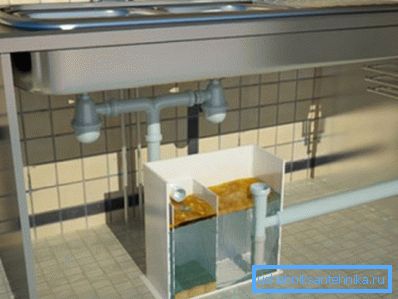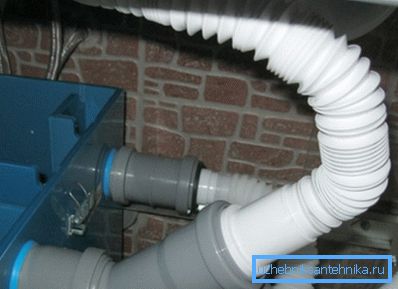Why do i need a grease trap under the sink and how to
Not so long ago, in private households in Western countries began to use grease catchers for washing. It is quite expected that there was a certain demand for them in our country, however, not everyone knows what these devices are and why they are needed at all. Therefore, below we will try to answer these questions, as well as consider how to install a grease trap under the sink with your own hands.

General information
Sewage blockages in homes and apartments are not uncommon. There are a lot of reasons for this, but one of the main reasons is to drain drains with a high content of fat that gets into the water as a result of washing dishes and cooking.
Fat settles on the walls of sewer pipes, which leads to a gradual narrowing of the passage until the pipe is completely clogged. As it is easy to guess, in order to prevent the “fouling” of the walls of the fat pipes, they also use the grease catchers for washing, which are also called fat separators or grease separators.
It should be noted that these devices have long been used in industrial kitchens, especially in catering establishments. For domestic purposes, however, grease separators have been used recently, but people quickly appreciated their benefits, with the result that they became widespread.

Note! Grease separators are especially needed for private houses with autonomous sewage. This is due to the fact that in the presence of this device at the point of collection, septic tanks work several times more efficiently.
Features of the grease separator
The principle of operation and differences of models
So, as mentioned above, the grease catchers are of two types:
- Industrial.
- Household.
The latter are a small septic tank, which is located under the sink. In the process of cooking and washing dishes, the device takes over the primary drains, clearing them from fat.

Works such a septic tank on the principle of the sump. As a rule, it is a rectangular container, inside of which there are partitions dividing the space into several chambers. Since the fatty particles are much lighter than water, they linger in a special settling chamber, and the water flows freely into the sewer.
It should be noted that household grease catchers are of two types:
| Standalone | To operate the device does not require a connection to electricity. |
| Electric | In this case, the pumping of fluid into the sewer system is carried out by force using an electric pump. Accordingly, for the operation of the device it is necessary to connect it to the power supply. |
In addition, the products differ in the principle of water intake:
| Volley | They are distinguished by the possibility of receiving a large amount of effluent during the peak discharge process. This model should be used in the event that you wash the dishes by typing water into the sink, after which its salvo drain occurs. |
| Wastewater | Designed for those cases when washing dishes is carried out under running water. |
Household grease traps for washing differ from industrial ones primarily because they are designed for processing a small amount of wastewater. As a rule, this indicator fluctuates within the limits of 0.5-1.5 meters cubic per hour.
Note! The performance of the device is selected depending on the number of people living in the house or apartment. The more people, the, respectively, the separator should be more productive.

Design
Virtually all household grease separators under the sink have the same design. As mentioned above, the container body has a rectangular shape.
Inside it are the following elements:
- Inlet - is designed to supply wastewater to the tank.
- Flow damper - reduces the rate of incoming water.
- Partition - ensures the retention of the precipitated masses and thereby prevents the overflow of settled sludge.
- Air outlet - designed to ventilate the tank.
- The final branch pipe - provides removal of the drained of fat drains in the sewerage.
As we can see, the design is extremely simple.

Merits
The main advantage of the grease catcher is, of course, the protection of the sewer system from pollution.
But, besides this, this device has other positive qualities:
- It has a compact size and low weight, so that connecting the device does not cause any difficulties.
- All parts are made of environmentally friendly materials.
- High work efficiency - fatty and oily substances are captured by 95 - 100 percent.
- Cleaning the grease trap under the sink is quite simple and does not take much time.
- A wide range of models, so you can always choose the right model of the device.
- Durability due to simplicity of design.
- Reasonable price, especially it concerns autonomous household models.
Thanks to all these moments, grease traps are widely used in everyday life.
disadvantages
As for the shortcomings, they are few. The main one is that periodically the oil tank under the sink needs to be cleaned.
This is done by any available tools or a special spatula, which is available in the kit. With its help, the sludge is simply drained from the tank, after which the grease trap is washed.

In addition, devices equipped with an electric pump, increase power consumption, and in case of its absence, do not work at all.
Installation
The installation manual for the grease separator is extremely simple - the device is installed in the gap between the sink drain and the sewer pipe. The connection is easiest to perform with a corrugated pipe.

As a rule, all seals and other elements necessary for connecting the device are included with the grease trap.
Therefore, the work is carried out in this order:
- First of all, you need to prepare a place under the sink and ensure unhindered access to the tank for its maintenance.. The surface on which the device will be located must be flat, without any flaws.
- Next you need to disconnect the discharge pipe of the siphon sink from the sewer pipe.
- Then the device is installed on the prepared place..
- A rubber seal is inserted into the inlet of the unit and a sink siphon is connected to it.. To seal the joints, all connections need to be smeared with silicone sealant for pipes.
- Similarly, the outlet is connected to the corrugation, which is inserted into the sewer pipe.

- After connecting the tank, it must be filled with water to the technological level..
- At the end of the work it is necessary to check the tightness of all connections.. To do this, you need to flush the water from the sink and make sure that there is no leakage at the joints.
This completes the installation of the grease separator. Now, for the effective operation of the device it is necessary only to clean it in time.
Conclusion
It is difficult to overestimate the benefits of installed grease catchers for washing, especially for private houses with autonomous sewage systems. At the same time, this device is inexpensive and easy to install. Thus, the growing popularity of household separators is quite natural.
From the video in this article, you can read some additional information on this topic.